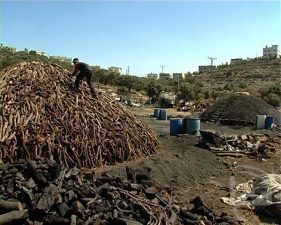Nature’s right to water was the focus of the latest conference in the wave of water crisis conferences in Israel in the past month (pun intended).
Giving water back to nature is not exactly top priority when Israelis are trying to limit consumption in order to ensure a source of drinking water for the future. The government is pushing drying up public and private gardens and parks to ease the burden on the already over-pumped Kinneret and underground aquifers.
So it’s easy to understand the skepticism that surrounds the idea of pumping clean, drinkable water back into dried-up stream beds, which is exactly what is already happening in several streams in Israel (see below picture of Hillel Glazman of the National Parks Authority “watering” Nahal Betzet).
But at the conference on Monday, at Tel Aviv University, after seeing picture after picture of springs and streams that are muddy remains of what they used to be, the severe situation of Israel’s streams is clear: We’re not really pumping potable water into streams – we are returning water to its rightful place.
Much like an annual budget, Israel calculates its water supply by making two columns: the “income” (supply) and the “expenses” (demand).
The supply is a sum of the previous years’ reserves (which don’t amount to much), rainfall accumulation, water produced by desalination, and “surplus” water saved through the implementation of water saving measures in drought years.
This supply is then divided between the water users, whose needs make up the demand. In decreasing order of consumption, the demand is: households, industry, agriculture, “neighbors” and nature. Nature always falls last and in future years, as household consumption rises with population increases, there is no plan to allocate nature any additional water.
What can the average citizen do in order to prevent the additional drying up of wetlands?
Unfortunately, not much. The public has no authority to make changes in Israel’s current water policy. We can, and should, work hard to save water at home – “every drop counts.” But no matter how much water we save, it will not impact the allocation that is earmarked for nature.
I’m still optimistic though. Israeli citizens, through grassroots efforts, have managed to initiate recycling, green business practices and green architecture without government assistance or intervention, so I see no reason why the same cannot be done in restoring and preserving Israel’s natural environment.
This guest post was written for Green Prophet by Jennifer Garr from the The Porter School of Environmental Studies at Tel Aviv University. The School offers degrees in Environmental Studies at PhD, Master’s and post-doc levels, and grants scholarships to its students.




very informative…
you really helped me with my assignment!☺